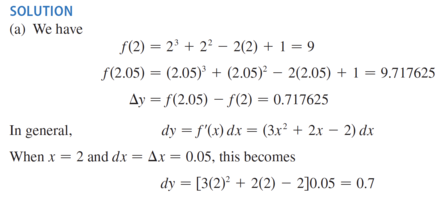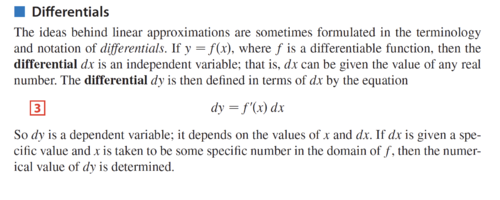Hi, I'm trying to wrap my head around how a differential is defined. We were given the function [imath]f(x) = x^3+x^2-2x+1[/imath] and asked to calculate [imath]dy[/imath] from 2 to 2.05 with [imath]dy[/imath] defined as [imath]dy = f'(x)dx[/imath]. I got the derivative of [imath]f'(x) = 3x^2+2x-2[/imath] and then calculated [imath]f'(x)[/imath] for both 2 and 2.05, subtracting [imath]f'(2) from f'(2.05)[/imath] and got the correct answer.
The book then says that, in general, [imath]dy[/imath] can be calculated using the formula [imath]dy = f'(x)dx[/imath], which in this case would be [imath]dy = (3x^2+2x-2)(.05)[/imath]. I'm thinking of this as a kind of factoring where the long way would be: [imath]dy = [3(2.05)^2-2(2.05)-2] - [3(2)^2+2(2)-2][/imath] and the short way [imath]dy=(3x^2+2x-2)(.05)[/imath], but for the life of me I can't see how this would be done. It's not a typical factoring formula like [imath](5sinx-3sinx)[/imath] where [imath]sinx[/imath] can be factored out because the 2 and 2.05 must be placed in the f'(x) expression. We're not multiplying f'(x) by 2 and 2.05, we're placing 2 and 2.05 inside as the variable, so I can't figure out how f'(x) can be isolated algebraically. Hope this is clear. Any help would be appreciated.
The book then says that, in general, [imath]dy[/imath] can be calculated using the formula [imath]dy = f'(x)dx[/imath], which in this case would be [imath]dy = (3x^2+2x-2)(.05)[/imath]. I'm thinking of this as a kind of factoring where the long way would be: [imath]dy = [3(2.05)^2-2(2.05)-2] - [3(2)^2+2(2)-2][/imath] and the short way [imath]dy=(3x^2+2x-2)(.05)[/imath], but for the life of me I can't see how this would be done. It's not a typical factoring formula like [imath](5sinx-3sinx)[/imath] where [imath]sinx[/imath] can be factored out because the 2 and 2.05 must be placed in the f'(x) expression. We're not multiplying f'(x) by 2 and 2.05, we're placing 2 and 2.05 inside as the variable, so I can't figure out how f'(x) can be isolated algebraically. Hope this is clear. Any help would be appreciated.



